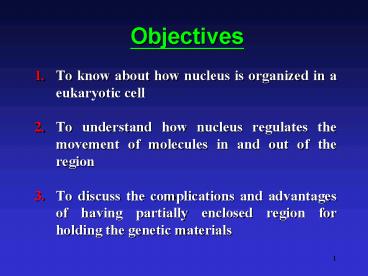Objectives - PowerPoint PPT Presentation
1 / 17
Title:
Objectives
Description:
To understand how nucleus regulates the movement of molecules in ... Rests on a network of supporting fibers (nuclear lamina) Nuclear pores ... Nuclear lamina ... – PowerPoint PPT presentation
Number of Views:60
Avg rating:3.0/5.0
Title: Objectives
1
Objectives
- To know about how nucleus is organized in a
eukaryotic cell - To understand how nucleus regulates the movement
of molecules in and out of the region - To discuss the complications and advantages of
having partially enclosed region for holding the
genetic materials
2
Nucleus
- The site within a eukaryotic cell where
- Chromosomes are localized and replicated
- DNA is transcribed
- Repository and control centre of most of the
cells genetic information
3
- Nuclear envelope
- Trilamellar appearance 2 membranes a
perinuclear space - Outer nuclear membrane
- Continuous with endoplasmic reticulum
(perinuclear space is continuous with ER lumen) - Studded on its outer surface with ribosomes
- Intermediate filaments anchoring nucleus to other
organelles / plasma membrane
4
(No Transcript)
5
- Inner nuclear membrane
- Rests on a network of supporting fibers (nuclear
lamina) - Nuclear pores
- Small cylindrical channels fusion of inner and
outer membranes direct continuity between
cytosol and nucleoplasm - Lined with an intricate protein structure
(nuclear pore complex NPC)
6
- Octagonal arrangement of subunits protrude on
both cytoplasmic and nucleoplasmic sides - Proteins extend into perinuclear space anchor
the pore complex - Transporter moves macromolecules across fibers
extend from the rings into cytosol and
nucleoplasm (forming a basket)
7
Transportation
- IN Enzymes / proteins for chromosome
replication and DNA transcription - OUT RNA molecules / partially assembled
ribosomes for protein synthesis - To protect newly synthesized RNA from being acted
upon by cytoplasmic organelles / enzymes before
it has been fully processed
8
- Passive Transport
- 8 separate aqueous diffusion channels (periphery
of the pore complex between the spokes) / 1
channel (center of transporter) - Freely permeable to ions and small molecules (lt10
nm)
9
- Active Transport
- Large proteins and RNA ( 26 nm)
- Requires energy specific binding of the
transported substance to membrane proteins - IN
- Amino acid sequences enabling the protein to be
recognized and transported into nucleus by NPC
(nuclear localization signals NLS)
10
(No Transcript)
11
- Cytoplasmic receptor proteins (importins) bind to
NLS mediate movement of proteins toward nuclear
pores - Binding of importins-NLS complex to cytoplasmic
side of NPC - The complex is transported into nucleus by
transporter (center of the pore) - GTP-hydrolyzing protein (Ran)
12
- OUT
- Ribonucleoprotein complexes
- Amino acid sequences targeting the complexes for
export through NPC (nuclear export signals NES) - Exportins bind to NES mediate the complexes to
transport out through NPC (mechanisms NLS
importins)
13
- Nucleoplasm
- The interior space of nucleus
- Nuclear matrix
- A protein network maintaining the shape of
nucleus - To provide an organizing scaffold for chromatin
fibers - Organizing DNA for orderly replication and
transcription - Guiding the newly formed mRNA to nuclear pores
transportation to cytoplasm
14
- Nuclear lamina
- A thin dense meshwork of fibers lining the inner
surface of inner nuclear membrane - To support nuclear envelope
- As attachment sites for chromatin
15
- Nucleolus
- The ribosome factory
- A membrane-free organelle consisting of DNA that
is being transcribed into rRNA (fibrils) rRNA
molecules being packed with proteins imported
from cytoplasm (granules)
16
- A stretch of DNA carrying multiple copies of rRNA
genes (nucleolus organizer region NOR) - Multiple copies are grouped into gt 1 NORs reside
on gt 1 chromosomes - A nucleolus may contain rRNA genes derived from gt
1 NORs
17
- Size of nucleolus is correlated with its level of
activity - Cell approaches division ? chromatin condenses
(as compact chromosomes) ? shrinkage ? nucleoli
disappear - Mitosis is ending ? chromatin uncoils ? NORs loop
out again ? rRNA synthesis resumes ? near the tip
of 10 chromosomes ? 10 NORs ? 10 tiny nucleoli
(in human) ? nucleoli enlarge ? fuse into a
single large nucleolus

